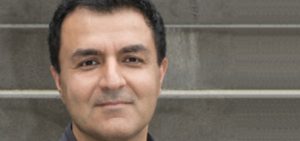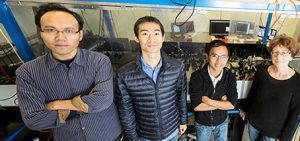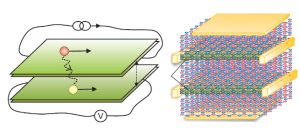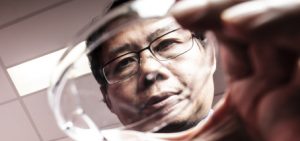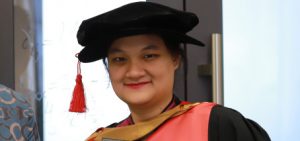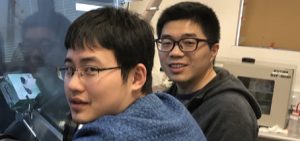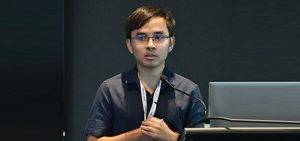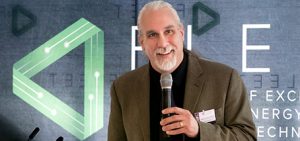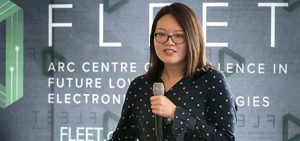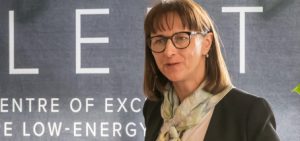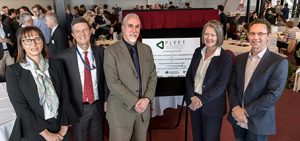Engage
See news from around FLEET, below
Catch up on all past issues of FLEET News newsletter
FLEET News
New materials inspired by nature could be key to future electronics Self-assembled nanostructures have atomically-precise structure and tailored electronic properties Bio organisms are the most-complex machines we know, and are capable of achieving demanding functions with great efficiency. A common theme in these bio-machines is that everything important happens at the level of single molecules – that is, at the …
Congratulations to FLEET’s Kourosh Kalantar-Zadeh — named an Australian Research Council Laureate Fellow today. Kourosh’s significant influences in engineering include two-dimensional (2D) transition metal compounds, liquid metals, microfluidics, sensors, electronic devices and medical systems. He is an expert in chemical and biochemical sensors, nanotechnology, microsystems, materials science, electronics, gastroenterology, medical devices and microfluidics, and has made internationally-recognised contributions to the …
Outstanding problem in exciton-polariton physics resolved using exceptional points at ANU Chirality of mode at EP opens future research avenues for exciton-polariton physics Researchers at ANU recently proved a novel method for generating orbital angular momentum states (vortices), with a topological charge that is ensured by an exceptional point. Recent studies at the ANU resolve an outstanding problem in exciton-polariton …
Why 2D? What is it about two-dimensional materials that makes them so interesting for FLEET? FLEET UNSW/Wollongong collaboration finds transition point from 3D to 2D properties Constraining the movement of charge carriers (electrons or holes) to two dimensions unlocks unusual quantum properties, resulting in useful electronic properties. Although we refer to the layers within such materials as ‘2D’, they are …
Taking a multiband approach explains ‘electron-hole reverse drag’ and exciton formation Mystifying experimental results obtained independently by two research groups in the USA seemed to show coupled holes and electrons moving in the opposite direction to theory. Now, a new theoretical study has explained the previously mysterious result, by showing that this apparently contradictory phenomenon is associated with the bandgap …
Discovery has potential applications in artificial muscles, soft robotics and microfluidic circuitry In a breakthrough discovery, University of Wollongong (UOW) researchers have created a “heartbeat” effect in liquid metal, causing the metal to pulse rhythmically in a manner similar to a beating heart. Their findings are published in the 11 July issue of Physical Review Letters, the world’s premier journal …
Maths and spin: key to new electronics A love of maths brought Elizabeth Marcellina to the study of quantum and condensed-matter physics, where her recently completed PhD research studied possible routes to faster, more efficient electronics, by harnessing the ‘spin’ of the carriers in common semiconductors. As Moore’s law is coming to an end, much effort has been devoted to …
FLEET RMIT—UNSW collaboration measuring transport properties of van der Waals heterostructures FLEET PhD Cheng Tan (RMIT) visited UNSW’s labs in May to perform magnetic coupling measurements on 2D ferromagnetic crystals. The visit was reciprocated this month with FLEET Research Fellow Feixiang Xiang (UNSW) visiting RMIT to construct van der Waals structures for studying of 2D topological systems. This collaboration between …
FLEET collaboration traps light–matter particles FLEET’s Research theme 2 seeks to create near-zero resistance flow of exciton polaritons, which are hybrid quasi-particles that are part matter and part light. Their ability to flow without resistance relies on formation of an exciton-polariton condensate – a collective quantum state that behaves as a superfluid. In superfluids, particles flow without encountering any resistance …
FLEET will deliver much more than excellent science for Australian society. We are training some of the next generation of scientists, engineers, and entrepreneurs. We will help them develop not only technical research skills, but also transferable skills that will be useful to them no matter what their eventual career direction. For example, we have ensured that our research groups …
The challenge of finding a sustainable path to continuing the IT revolution is critical, and time is running out. I can tell you today with reasonable certainty that Moore’s Law will be declared dead within the seven-year operation of the Centre–perhaps even before our mid-term review! Computer chips will cease to gain in efficiency, and yet our demand for computation …
The information technology revolution has improved our lives, and we want it to continue. For example, our smartphone has become one of the most important devices of our everyday life: we use it to access up-to-date weather predictions, to plot the best route through traffic, and to watch the new series of House of Cards. And we expect it be …
Our insatiable appetite for computing means ITC already consumes 5–8% of global electricity, and is doubling each decade. Unless that ever-growing demand for computing can continue to be met with efficiency gains, the information revolution will slow down from power hunger. At the launch of a new Australian Research Council Centre of Excellence the audience heard that efficiency gains in current, …
Official launch: Australian Research Council Centre of Excellence in Future Low-Energy Electronics Technologies 12 June 2018, 11 AM New Horizons Building, Monash University, Clayton We have an insatiable appetite for computing. But our ongoing need for computation is burning more than 5 percent of global electricity. And that figure is expected to double each decade. A new Australian Research Council …
When using an electronic device to watch tv, listen to music, model the weather or any other task that requires information to be processes, there are millions and millions of binary calculations going on in the background. There are zeros and ones being flipped, added, multiplied and divided at incredible speeds. The fact that a microprocessor can perform these calculations …


